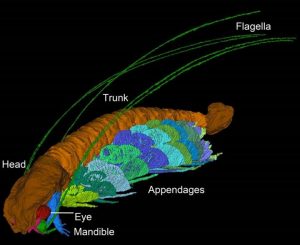
An international team of scientists led by the University of Leicester has discovered a new 430 million-year-old fossil and has named it in honour of Sir David Attenborough – who grew up on the University campus.
The fossil is described as ‘exceptionally well preserved in three-dimensions’ – complete with the soft-parts of the animal, such as legs, eyes and very delicate antennae. The fossil has been determined as an ancient crustacean new to science – a distant relative of the living lobsters, shrimps and crabs. There are about 40,000 crustacean species known today.
The find comes from volcanic ash deposits that accumulated in a marine setting in what is now Herefordshire in the Welsh Borderland.
Professor David Siveter of the Department of Geology at the University of Leicester made the discovery working alongside researchers from the Universities of Oxford, Imperial College London and Yale, USA.
Professor Siveter said: “Such a well-preserved fossil is exciting, and this particular one is a unique example of its kind in the fossil record, and so we can establish it as a new species of a new genus.”
“Even though it is relatively small, at just nine millimetres long, it preserves incredible detail including body parts that are normally not fossilized. It provides scientists with important, novel insights into the evolution of the body plan, the limbs and possible respiratory-circulatory physiology of a primitive member of one of the major groups of Crustacea.”
The fossil is named Cascolus ravitis in honour of Sir David, who grew up on University College Leicester campus (the forerunner of the University), in celebration of his 90th birthday. Cascolus is derived from castrum meaning ‘stronghold’ and colus, ‘dwelling in’, alluding to the Old English source for the surname Attenborough; while ‘ravitis” is a combination of Ratae – the Roman name for Leicester – ‘vita’, life, and ‘commeatis’, a messenger.
Professor Siveter said: “In my youth, David Attenborough’s early programmes on the BBC, such as ‘Zoo Quest’, greatly encouraged my interest in Natural History and it is a pleasure to honour him in this way.”
Sir David Attenborough said: “The biggest compliment that a biologist or palaeontologist can pay to another one is to name a fossil in his honour and I take this as a very great compliment. I was once a scientist so I’m very honoured and flattered that the Professor should say such nice things about me now.”
Professor Siveter added: “The animal lived in the Silurian period of geological time. Some 430 million years ago much of southern Britain was positioned in warm southerly subtropical latitudes, quite close to a large ancient continent of what we now call North America, and was covered by a shallow sea. The crustacean and other animals living there died and were preserved when a fine volcanic ash rained down upon them.”
The fossil specimen has been reconstructed as a virtual fossil by 3D computer modeling.
Reference:
David J. Siveter, Derek E. G. Briggs, Derek J. Siveter, Mark D. Sutton, David Legg. A new crustacean from the Herefordshire (Silurian) Lagerstätte, UK, and its significance in malacostracan evolution. DOI: 10.1098/rspb.2017.0279
Note: The above post is reprinted from materials provided by University of Leicester.










